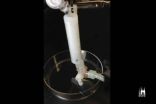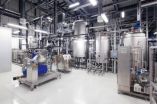(Press-News.org) Plans for a new type of DNA vaccine to protect against the deadly HIV and Hepatitis C viruses have taken an important step forward, with University of Adelaide researchers applying for a patent based on groundbreaking new research.
Professor Eric Gowans from the University's Discipline of Surgery, based at the Basil Hetzel Institute at the Queen Elizabeth Hospital, has submitted a patent application for what he describes as a relatively simple but effective technique to stimulate the body's immune system response, thereby helping to deliver the vaccine.
While pre-clinical research into this vaccination technique is still underway, he's now searching for a commercial partner to help take it to the next stage.
Professor Gowans' work has focused on utilizing the so-called "accessory" or "messenger" cells in the immune system, called dendritic cells, to activate an immune response. These are a type of white blood cell that play a key role during infection and vaccination.
"There's been a lot of work done in the past to target the dendritic cells, but this has never been effective until now," Professor Gowans says. "What we've done is incredibly simple, but often the simple things are the best approach. We're not targeting the dendritic cells directly – instead, we've found an indirect way of getting them to do what we want."
Professor Gowans and his team have achieved this by including a protein that causes a small amount of cell death at the point of vaccination.
"The dead cells are important because they set off danger signals to the body's immune response. This results in inflammation, and the dendritic cells become activated. Those cells then create an environment in which the vaccination can be successful," Professor Gowans says.
Using a micro-needle device provided by United States company FluGen Inc., the researchers can puncture the skin to a depth of 1.5mm, delivering the vaccination directly into the skin. "We chose the skin instead of the muscle tissue, which is more common for DNA vaccines, because the skin has a high concentration of dendritic cells," Professor Gowans says.
Because the technique has the potential to translate to other, more common viruses in addition to the devastating HIV and Hepatitis C, the project attracted seed funding from The Hospital Research Foundation, and additional funding from the National Health and Medical Research Council (NHMRC).
The research is still in the pre-clinical phase, with a patient study due next year. "This technique has worked much better than I anticipated," Professor Gowans says. "We're now ready for a commercial partner to help us take this to the next phase, and we're in discussions with some potential partners at the moment."
Professor Gowans will present some of his work at the forthcoming 5th Australasian Vaccines & Immunotherapeutics Development Meeting (AVID2014), 7-9 May in Melbourne, Australia. Last month he was an invited speaker at the 23rd Australian Conference on Microscopy and Microanalysis (ACMM23) in Adelaide. A paper about this work has already been published recently in Immunology & Cell Biology.
INFORMATION:
Media Contact:
Professor Eric Gowans
NHMRC Senior Research Fellow
Discipline of Surgery, The University of Adelaide
Basil Hetzel Institute, The Queen Elizabeth Hospital
Phone: +61 8 8133 4003
eric.gowans@adelaide.edu.au
New technique brings us closer to HIV and Hepatitis C vaccines
2014-03-25
ELSE PRESS RELEASES FROM THIS DATE:
Catheter innovation destroys dangerous biofilms
2014-03-25
DURHAM, N.C. -- For the millions of people forced to rely on a plastic tube to eliminate their urine, developing an infection is nearly a 100 percent guarantee after just four weeks. But with the help of a little bubble-blowing, biomedical engineers hope to bring relief to urethras everywhere.
About half of the time, the interior of long-term urinary catheters become plagued by biofilms -- structures formed by colonies of bacteria that are extremely difficult to kill. Once established, it is only a matter of time before the biofilm becomes a welcoming host for other, ...
Doxorubicin alone or with ifosfamide for treating soft tissue sarcoma?
2014-03-25
An EORTC study published in The Lancet Oncology does not support administration of intensified doxorubicin and ifosfamide for palliation of advanced soft tissue sarcoma, unless the objective is to shrink the tumor.
Dr. Ian Judson of the Royal Marsden Hospital in London and coordinator of this study says, "Our clinical trial was designed to compare combination treatment with doxorubicin and ifosfamide to treatment with doxorubicin alone, and our results show that the combination chemotherapy did not improve overall survival. So, if the goal of treatment is to control the ...
Leading surgeons warn against media hype about tracheal regeneration
2014-03-25
Beverly, MA, March 24, 2014 – Reports of the two earliest tissue-engineered whole organ transplants using a windpipe, or trachea, created using the patient's own stem cells, were hailed as a breakthrough for regenerative medicine and widely publicized in the press. However, two leading transplant surgeons in Belgium warn of the dangers of media attention, and urge that tracheal bioengineering be demonstrated as both effective and safe before further transplants take place. Their views are published in an Editorial in The Journal of Thoracic and Cardiovascular Surgery, an ...
Research study takes deeper look at the role of gut microbes in the immune system
2014-03-25
LOS ANGELES (March 24, 2014) – New research suggests that gut microorganisms do not merely influence immune cell function, but also support the production of immune cells that form the first line of defense against infection. By understanding the mechanisms responsible for maintaining and replacing immune cells, researchers hope to one day develop targeted therapies to support and boost immune function in humans.
Study investigators from the Regenerative Medicine Institute at Cedars-Sinai collaborated with the Mount Sinai School of Medicine and lead institution — the ...
Replacing insulin through stem cell-derived pancreatic cells under the skin
2014-03-25
LA JOLLA, Calif., March 25, 2014 – Sanford-Burnham Medical Research Institute (Sanford-Burnham) and UC San Diego School of Medicine scientists have shown that by encapsulating immature pancreatic cells derived from human embryonic stem cells (hESC), and implanting them under the skin in animal models of diabetes, sufficient insulin is produced to maintain glucose levels without unwanted potential trade-offs of the technology. The research suggests that encapsulated hESC-derived insulin-producing cells hold great promise as an effective and safe cell-replacement therapy ...
Complex brain functional network connection after stroke
2014-03-25
Studies have shown that functional network connection models can be used to study brain network changes in patients with schizophrenia. A research team from Huazhong University of Science and Technology in China inferred that these models could also be used to explore functional network connectivity changes in stroke patients. The researchers used independent component analysis to find the motor areas of stroke patients, which is a novel way to determine these areas. Functional magnetic resonance imaging datasets were collected from healthy controls and right-handed stroke ...
Technofossils -- an unprecedented legacy left behind by humans
2014-03-25
A new study by an international team of scientists, including Dr Jan Zalasiewicz and Professor Mark Williams of the University of Leicester's Department of Geology, suggests that the fossil impact humans have made on the planet is vast and unprecedented in nature – and that there's been nothing remotely like it since the Earth formed, over four and half billion years ago.
The study, entitled 'The technofossil record of humans' and published by SAGE in The Anthropocene Review, argues that, like dinosaurs, who left their bones and footprints behind for future generations ...
Managing renewables intelligently
2014-03-25
"Wind, solar and biogas are all energy sources with their own strengths and weaknesses. And it's by combining the strengths of each in a smart way that we'll be able to guarantee Germany's energy supply into the future," says Dr. Kurt Rohrig, deputy director of the Fraunhofer Institute for Wind Energy and Energy System Technology IWES in Kassel. But what happens when, instead of a big power plant, you have a host of individual small energy producers feeding in energy to the grid at varying times? Is reliable operation of the grid still technically feasible? In the "Combined ...
Sugar, not oil
2014-03-25
Plastic, gasoline, rubber – very many items we use every day are based on oil. But this raw material is becoming increasingly scarcer. Step by step researchers are therefore investigating possibilities for using renewable raw materials to replace oil. One well-known example of this is biodiesel, which comes not from oil sources, but from fields of yellow-flowering rape. In future it is planned to produce another substance from plants, namely isobutene, a basic chemical used in the chemical industry to produce fuels, solvents, elastomers or even antiknock agents in fuel. ...
Plasma tool for destroying cancer cells
2014-03-25
Plasma medicine is a new and rapidly developing area of medical technology. Specifically, understanding the interaction of so-called atmospheric pressure plasma jets with biological tissues could help to use them in medical practice. Under the supervision of Sylwia Ptasinska from the University of Notre Dame, in Indiana, USA, Xu Han and colleagues conducted a quantitative and qualitative study of the different types of DNA damage induced by atmospheric pressure plasma exposure, the paper is published in EPJ D as part of a special issue on nanoscale insights into Ion Beam ...


